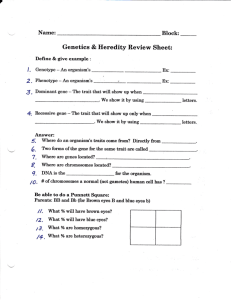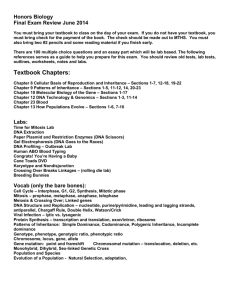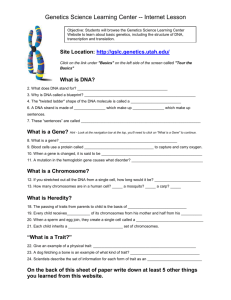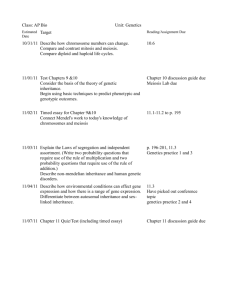Freshman Biology Semester II Exam Study Guide
advertisement
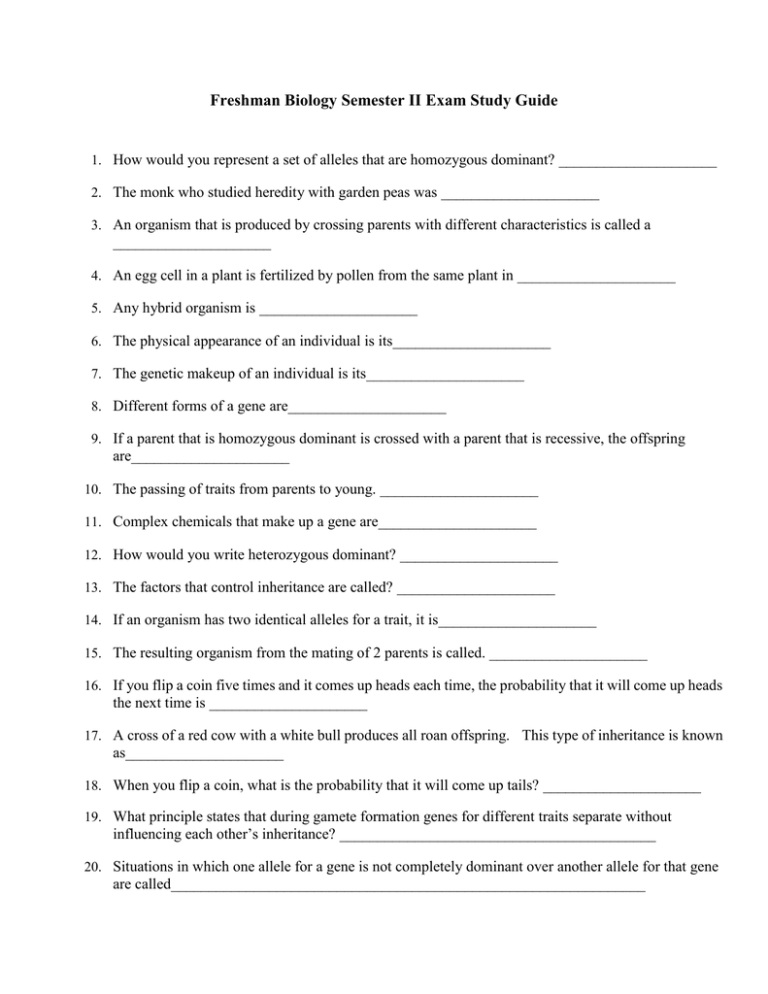
Freshman Biology Semester II Exam Study Guide 1. How would you represent a set of alleles that are homozygous dominant? _____________________ 2. The monk who studied heredity with garden peas was _____________________ 3. An organism that is produced by crossing parents with different characteristics is called a _____________________ 4. An egg cell in a plant is fertilized by pollen from the same plant in _____________________ 5. Any hybrid organism is _____________________ 6. The physical appearance of an individual is its_____________________ 7. The genetic makeup of an individual is its_____________________ 8. Different forms of a gene are_____________________ 9. If a parent that is homozygous dominant is crossed with a parent that is recessive, the offspring are_____________________ 10. The passing of traits from parents to young. _____________________ 11. Complex chemicals that make up a gene are_____________________ 12. How would you write heterozygous dominant? _____________________ 13. The factors that control inheritance are called? _____________________ 14. If an organism has two identical alleles for a trait, it is_____________________ 15. The resulting organism from the mating of 2 parents is called. _____________________ 16. If you flip a coin five times and it comes up heads each time, the probability that it will come up heads the next time is _____________________ 17. A cross of a red cow with a white bull produces all roan offspring. This type of inheritance is known as_____________________ 18. When you flip a coin, what is the probability that it will come up tails? _____________________ 19. What principle states that during gamete formation genes for different traits separate without influencing each other’s inheritance? __________________________________________ 20. Situations in which one allele for a gene is not completely dominant over another allele for that gene are called_______________________________________________________________ Figure 11-1 21. Refer to Figure 11-1. If individual III-2 marries a person with the same genotype as individual I-1, what is the chance that one of their children will be afflicted with hemophilia? _____________________ 22. What type of inheritance pattern does the trait represented by the shaded symbols in Figure 11-1 illustrate? _____________________ 23. For the trait being followed in the pedigree, individuals II-1 and II-4 in Figure 11-1 can be classified as _____________________ 24. Examine the graph in Figure 11-3, which illustrates the frequency in types of skin pigmentation in humans. Another human trait that would show a similar inheritance pattern and frequency of distribution is _____________________ 25. Which blood type is the universal donor of all blood types? _____________________ 26. Nondisjunction is related to a number of serious human disorders. How does nondisjunction cause these disorders? _________________________________________________________________________________ _________________________________________________________________________________ _________________________________________________________________________________ 27. What occurs during the process of meiosis in humans that can lead to a child with the condition of Down Syndrome? _________________________________________________________________________________ _________________________________________________________________________________ 28. Colorblindness is more common in males than in females because _________________________________________________________________________________ _________________________________________________________________________________ 29. Because the X chromosome contains genes that are vital for normal development, no baby has been born _____________________ 30. A boy who has hemophilia inherited the disorder from his _____________________ 31. What part of the chromosome might be involved with processes such as aging and cancer? ________________________________________________________________________________ 32. A rare hereditary abnormality characterized by the formation of linear skin lesions slightly resembling the appearance of fish scales had been passed down for 4 generations. All of the sons were affected and none of the daughters were affected. What can you infer about this disease? 33. During which phase is a karyotype produced? _____________________ 34. Which of the following allows for removal of fetal cells to test for genetic abnormalities. a. Amniocentesis c. both a and b b. Chorionic Villus Sampling d. none of the above 35. _____________________cannot breakdown amino acid, phenylalanine, leading to mental retardation unless given a special diet 36. _____________________usually aggressive, has a hard time conforming to societies rules, often end up in prison 37. What form(s) a Barr body_____________________ 38. The abnormality of the karyotype shown in Figure 11-7 is _____________________ 39. How would you write the scientific name of the Northern cardinal? _______________________________________________________________ 40. Which of the following is the most general taxon? a. genus c. phylum b. kingdom d. species 41. Llamas and Alpacas are classified as different species, yet they can interbreed and produce fertile offspring. For which species concept does this represent a limitation? 42. . Conifers and Lilies cannot trade places on the cladogram because Conifers do not have _____________________ 43. What assumption is made when constructing a cladogram? 44. Which domain includes organisms that are called extremophiles? _____________________ 45. Which of the following Kingdoms is not included in the Domain Eukarya? a. Bacteria c. Plantae b. Fungi d. Protista 46. Which character distinguishes Fungi from Plantae? _____________________ 47. Who was the first scientist to use binomial nomenclature? _____________________ 48. Which species concept defines a species in terms of patterns of ancestry and descent? _______________________________________________________________ 49. Which cell wall material distinguishes all of the organisms in Kingdom Plantae? _____________________ 50. Which of the following is a nucleic acid surrounded by a protein coat? a. Eubacteria c. Fungi b. Virus d. Protists 51. Characters can be biochemical or __________________________________________ 52. What does not possess cells, nor are cells__________________________________________ 53. All members of the Kingdom_____________________are multicellular and heterotrophic. 54. Which is the best description of the events that take place during anaphase II? 55. What is the role of the spindle fibers? _________________________________________________________________________________ _________________________________________________________________________________ 56. The typical human body cell contains 46 chromosomes. How many chromosomes are found in a typical human sperm? _______________________________________________________________ Figure 10-10 57. Which stage of meiosis is represented in Figure 10-10? _____________________ 58. If an organism’s diploid number is 12, its haploid number is _____________________ 59. Gametes are produced by the process of _____________________ Figure 11-3 60. 61. 62. 63. 64. 65. 66. 67. 68. What is shown in Figure 11-3? _____________________ Chromosomes form tetrads during_____________________ Unlike mitosis, meiosis results in the formation of_____________________ Produces daughter cells that are genetically identical_____________________ Involves two sets of nuclear divisions_____________________ Occurs during asexual reproduction_____________________ Name the small segments of the lagging DNA strand. _____________________ What are found in between the nitrogenous bases? _____________________ What are the basic chain of events in all organisms for reading and expressing genes? 69. How many nucleotides are in a codon? _____________________ 70. What are the purines and pyrimadines?? 71. In the RNA molecule, uracil replaces _____________________ 72. DNA differs from RNA because DNA has __________________________________________ 73. What enzyme is not involved in DNA replication? What enzymes are involved in DNA replication? _________________________________________________________________________________ _________________________________________________________________________________ 74. Which type of gene causes cells to become specialized in structure and in function? _________________________________________________________________________________ 75. DNA is copied during a process called __________________________________________ 76. In eukaryotes, DNA 77. What happens during the process of translation? 78. Using the sentence, “ The big fat cat,” write an example of deletion? 79. 80. 81. 82. A mutation that involves a single nucleotide is called a(an) _____________________ If the mRNA is AUG then what is the Animo Acid_____________________ Viruses are not placed in the biological classification system because_____________________ Which is a result of conjugation? _________________________________________________________________________________ 83. Which describes a retrovirus? _________________________________________________________________________________ 84. Viral DNA is integrated with the genetic material of a host cell during the _____________________ 85. An infectious, protein substance is called a (n) _____________________ 86. Eubacteria and archaebacteria differ in_______________________________________________________________________________ _________________________________________________________________________________ Figure 19-2 87. Figure 19-2 shows how prokaryotes can be identified by_____________________ 88. Which cell shape in Figure 19-2 is called a coccus? _____________________ 89. How do you identify prokaryotes? 90. Bacteria that break down the nutrients in dead matter into simpler substances that are taken up by plant roots are called _______________________________________________________________ 91. Many cases of food poisoning are caused by bacterial_____________________ 92. Bacteria that cause disease are called_____________________ 93. What foods are made using bacteria? 94. Food stored in a refrigerator will keep longer because the bacteria that spoil food _________________________________________________________________________________ _________________________________________________________________________________ 95. The outer protein coat of a virus is called a _____________________ 96. All viruses are made of proteins and_____________________ 97. Punnet Squares: Use the space provided to write out your complete answer to the statement. Running = R Black = B Waltzing = r Brown = b Cross a heterozygous running mouse with a waltzing mouse. Genotypes (ratios only) Phenotypes (ratios only)

